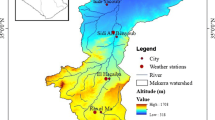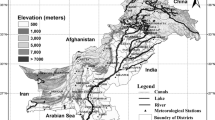Abstract
The drought has had a significant impact on West Nusa Tenggara. Drought experienced in some areas almost every year, causing crop failure and even causing famine in 1954 and 1966. This study aims to find the best method for obtaining the meteorological drought index because it is essential to understand the drought characteristics in the study area in guiding policymakers in early anticipation of this region’s drought hazard. This study compares two drought index methods, SPI and PDSI, and tests their proximity to drought data in these locations. Evaluation is carried out to determine the best approach to choose for conducting a drought assessment. The best-fitted method was determined statistically by counting the number of dry months produced by the model and comparing it with the drought experienced over West Nusa Tenggara. The results obtained are the SPI method has an accuracy rate of 58% and a correlation coefficient r about 0.06. Meanwhile, the PDSI method has a better accuracy rate of 75% and a correlation coefficient r about 0.51. The PDSI method is also the most superior in accurately predicting the arrival of a dry month compared to SPI. So, it can be concluded that the PDSI method is the better method for evaluating and detecting dry periods in West Nusa Tenggara.
Access this chapter
Tax calculation will be finalised at checkout
Purchases are for personal use only
Similar content being viewed by others
References
Gao L, Zhang Y (2016) Spatio-temporal variation of hydrological drought under climate change during the period 1960–2013 in the Hexi Corridor. China J Arid Land 8:157–171. https://doi.org/10.1007/s40333-015-0022-3
Zhang J, Sun F, Lai W, Lim WH, Liu W, Wang T, Wang P (2019) Attributing changes in future extreme droughts based on PDSI in China. J Hydrol 573:607–615. https://doi.org/10.1016/j.jhydrol.2019.03.060
McMahon T (1982) Arenas A D. Methods of computation flows. Gustard 107
Pathak AA, Dodamani BM (2020) Comparison of meteorological drought indices for different climatic regions of an Indian river basin. Asia-Pac J Atmos Sci 56:563–576. https://doi.org/10.1007/s13143-019-00162-5
Chelton DB, Risien CM (2020) A hybrid precipitation index inspired by the SPI, PDSI, and MCDI. Part II: application to investigate precipitation variability along the West Coast of North America. J Hydrometeorol 21:1977–2002. https://doi.org/10.1175/JHM-D-19-0231.1
Zou L, Xia J, She D (2017) Drought characteristic analysis based on an improved PDSI in the Wei River Basin of China. Water 9:178. https://doi.org/10.3390/w9030178
Haied N, Foufou A, Chaab S, Azlaoui M, Khadri S, Benzahia K, Benzahia I (2017) Drought assessment and monitoring using meteorological indices in a semi-arid region. Energ Procedia 119:518–529. https://doi.org/10.1016/j.egypro.2017.07.064
Abbasian MS, Najafi MR, Abrishamchi A (2021) Increasing risk of meteorological drought in the Lake Urmia basin under climate change: introducing the precipitation–temperature deciles index. J Hydrol 592:125586. https://doi.org/10.1016/j.jhydrol.2020.125586
Swain S, Patel P, Nandi S (2017) Application of SPI, EDI and PNPI using MSWEP precipitation data over Marathwada, India In: 2017 IEEE International Geoscience and Remote Sensing Symposium (IGARSS) pp 5505–5507. https://doi.org/10.1109/IGARSS.2017.8128250
Tirivarombo S, Osupile D, Eliasson P (2018) Drought monitoring and analysis: Standardised precipitation evapotranspiration index (SPEI) and standardised precipitation index (SPI). Phys Chem Earth Parts A/B/C 106:1–10. https://doi.org/10.1016/j.pce.2018.07.001
Quiring SM, Papakryiakou TN (2003) An evaluation of agricultural drought indices for the Canadian prairies. Agric For Meteorol 118:49–62. https://doi.org/10.1016/S0168-1923(03)00072-8
Dehghan S, Salehnia N, Sayari N, Bakhtiari B (2020) Prediction of meteorological drought in arid and semi-arid regions using PDSI and SDSM: a case study in Fars Province. Iran J Arid Land 12:318–330. https://doi.org/10.1007/s40333-020-0095-5
Huang S, Li P, Huang Q, Leng G, Hou B, Ma L (2017) The propagation from meteorological to hydrological drought and its potential influence factors. J Hydrol 547:184–195. https://doi.org/10.1016/j.jhydrol.2017.01.041
Vasiliades L, Loukas A (2009) Hydrological response to meteorological drought using the Palmer drought indices in Thessaly. Greece Desalination 237:3–21. https://doi.org/10.1016/j.desal.2007.12.019
Badan Pusat Statistik Provinsi Nusa Tenggara Barat (2017) Luas Daerah Nusa Tenggara Barat 2015–2017. https://ntb.bps.go.id/indicator/153/56/1/luas-daerah-nusa-tenggara-barat.html. Last accessed 30 Mar 2021
World Meteorological Organization (2012) Standardized precipitation index user guide
Adhyani NL, June T, Sopaheluwakan A (2017) Exposure to drought: duration, severity and intensity (Java, Bali and Nusa Tenggara).In: IOP conference series: earth and environmental science, vol 58, p 012040. https://doi.org/10.1088/1755-1315/58/1/012040
De Silva RP, Dayawansa NDK, Ratnasiri MD (2007) A comparison of methods used in estimating missing rainfall data. J Agric Sci 3:101–108
Schrier van der G, Jones PD, Briffa KR (2011) The sensitivity of the PDSI to the Thornthwaite and Penman-Monteith parameterizations for potential evapotranspiration. J Geophys Res Atmos 116. https://doi.org/10.1029/2010JD015001
McKee TB, Doesken NJ, Kleist J (1993) The relationship of drought frequency and duration to time scales. 6
Author information
Authors and Affiliations
Corresponding author
Editor information
Editors and Affiliations
Rights and permissions
Copyright information
© 2023 The Author(s), under exclusive license to Springer Nature Singapore Pte Ltd.
About this paper
Cite this paper
Saidah, H., Sulistiyono, H., Negara, I.D.G.J. (2023). Comparison of Suitable Drought Indices for Over West Nusa Tenggara. In: Kristiawan, S.A., Gan, B.S., Shahin, M., Sharma, A. (eds) Proceedings of the 5th International Conference on Rehabilitation and Maintenance in Civil Engineering. ICRMCE 2021. Lecture Notes in Civil Engineering, vol 225. Springer, Singapore. https://doi.org/10.1007/978-981-16-9348-9_51
Download citation
DOI: https://doi.org/10.1007/978-981-16-9348-9_51
Published:
Publisher Name: Springer, Singapore
Print ISBN: 978-981-16-9347-2
Online ISBN: 978-981-16-9348-9
eBook Packages: EngineeringEngineering (R0)




